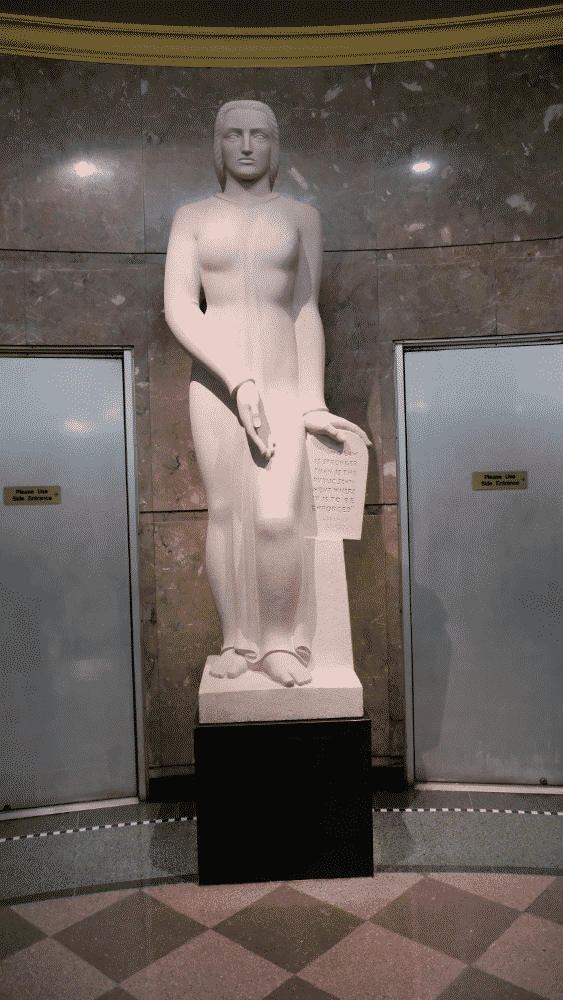Public Art Conservation; Sculpture Conservation:
The conservation treatment of stone is a delicate process despite the seemingly robust nature of the material. At McKay Lodge Conservation, we are pleased to have a specialized stone conservator on staff, Marcin Pikus. Conservator Pikus recently traveled to sunny Los Angeles, California to perform the conservation treatment of two stone sculptures. Also, as part of the project, seismic recommendations were provided by Conservator Christina L. Simms.
The two sculptures in question are Young Lincoln and Law, which stand at opposite ends of the Main Street lobby in the Federal Courthouse on North Spring Street. Young Lincoln, by James Lee Hansen is a standing male figure that depicts a young Abraham Lincoln looking down, in what appears to be a pensive mood. He is bare-chested and holds a book in his proper left hand. Each figure is carved in an abstract, austere style. They sit on polished, black granite pedestals. Law by Archibald Garner depicts a female figure carved from a single block of limestone. She wears robes that fall to the floor and her proper left hand rest on an inscribed tablet.

While the sculptures are in relatively good condition, they are readily accessible to the public. As a result, the surface of the limestone sculptures have grime and skin oils on the surface from touching by visitors as well as a normal accumulation of dirt that collects over time. These issues caused a superficial darkening of the limestone, especially around the hands, feet, bases, and bottom folds of the carved clothing.
For the treatment, the first step was a controlled removal of the dust from the stone surface using a bristle brush and a vacuum cleaner equipped with a custom-made suction nozzle with a brush attachment. A wet cleaning using a steamer accompanied by a specialized limestone cleaner was used next. The limestone conservation treatment removed the dark, soiled layer revealing the beautiful off-white stone beneath.

The pedestals, though, also in good condition had some issues that required attention. The granite surfaces had several scratches and some trace amounts of wax likely from floor cleaning equipment used in the past. Wax was removed manually with the help of solvent, and the preexisting marks were saturated with a sealer/enhancer product, creating a uniform surface.
To keep the sculptures in good condition, maintenance suggestions were provided for regular dust removal using dry methods only as well as a stanchion or other type of barricade to prevent touching from passersby.
Seismic recommendations were also provided based on visual inspection, discussion with other conservators, and a literature review, including a recent publication When Galleries Shake: Earthquake Damage Mitigation for Museum Collections by Jerry Podany. Earthquakes cannot be predicted like the weather, and various approaches for their prediction exist. For many museums and cultural institutions, it is a careful balance that must be struck between the cost of seismic mitigation versus the likelihood of a catastrophic scenario.
The building which houses the statues is in an area of high seismic activity where large earthquakes occur every 100 to 300 years. While the tall and slender sculptures are at risk, they are also solid construction, and they have withstood several major earthquakes since the mid 20th century. The construction of the artwork, previous seismic history in the region, and the aesthetic ramifications on the artwork from various restraints, mounts, or specialized bases, if implemented, were all considered before providing a report to the client.
A final after treatment image of Law depicts a surface that is even overall, a similar appearance to when the limestone was first carved by the artist. The darkened, soiled areas have been removed and residual wax and scratches were reduced on the black granite pedestals.

